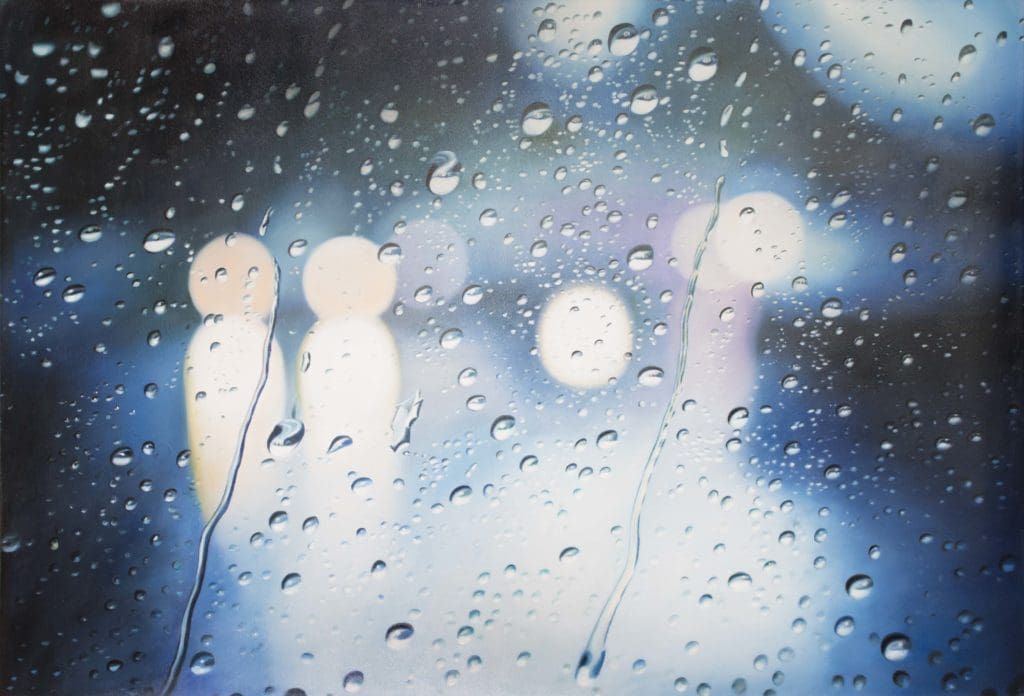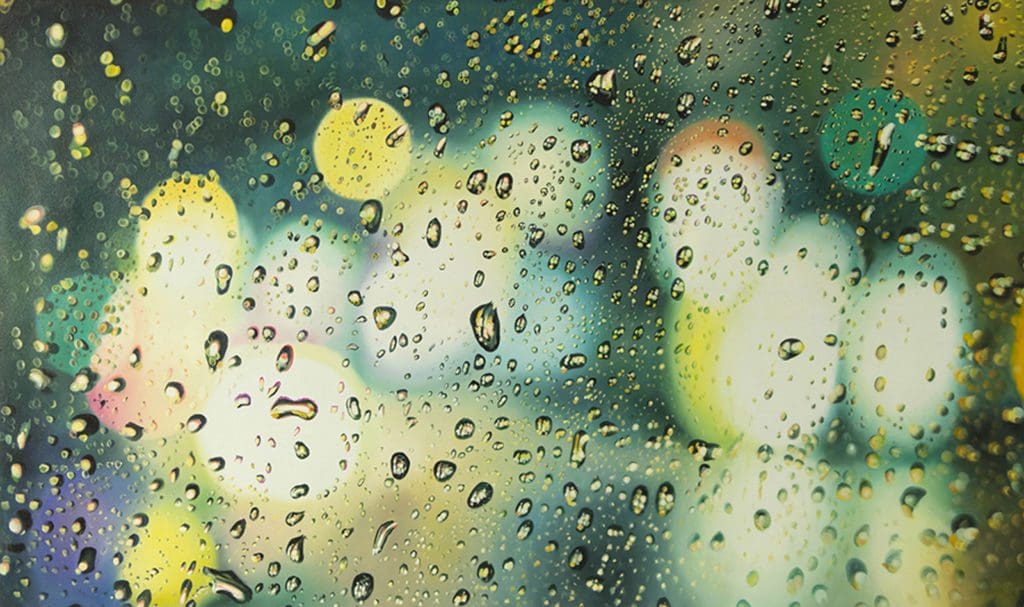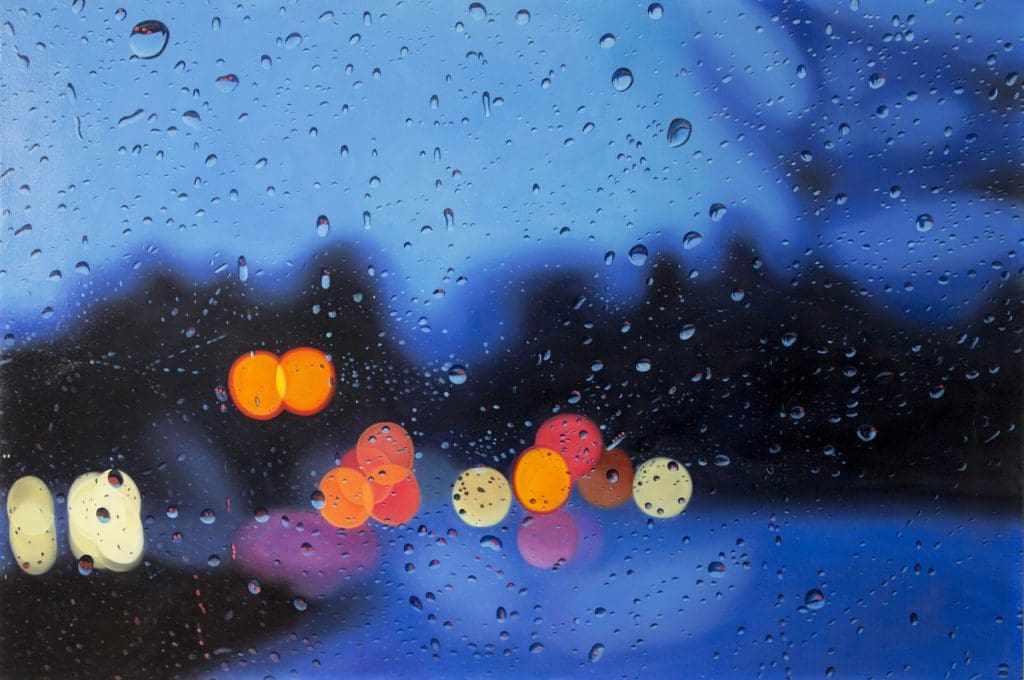Shay Kun’s work is as captivating as it is mystifying. Abstract but with a nod to photorealism, Kun’s work is largely conceptual, evoking complicated emotions through it’s subject matter. We recently had the opportunity to catch up with the artist and learn more about his history and process.

When did you start creating art?
I started painting in a very early age 3, 4 years old…I remember myself in my childhood sitting down in my mom’s studio — a commercial landscape artist, asking myself if these welcoming ‘greeting card‘ paintings are in my genes…at that time I could only produce a pastiche of Freudian Van Gogh type of work and this affliction of sublime testimony seemed too simple and sincere to justify. In retrospect I know today that both of my parents’ work shaped my style, those untouchable materials in my youth and through my education became the only motives that put a choke hold on me and did not let go. My exploration is not a tongue in cheek, a one liner of an Israeli artist flipping the European/ American sublime, but an emotional exploration of the point of departure between my mom’s celebratory landscape and my Dad’s decaying and deteriorating ones and how I can add to that my own small voice liquefying this ‘unfinished symphony‘. As a first generation Holocaust survivor; a son of two second world war immigrant artists, in many ways my practice is a reaction or negation to what was the conventional Israeli tradition of nature painting, where my parents too found themselves excluded as they were brought up by east European values and my work infuses both their styles while taking it to unmapped territories while bridging these crossroads.
How has your work evolved over the years?
I have always been consumed with the notion of escape and escapism and those items were so loaded for me that I could not asked for a better vehicle to explore my notions in depth regardless of territory shifts, my practice is very accessible however I am not intending to feed the viewer with a spoon so it’s a given that some scripts will be lost with the viewer nevertheless she is left with enough meat to chew on. There’s incredible creative energy in looking at what you were given as you grew up, and then making a version of it later on. You make it with much more knowledge and intelligence. It’s like, ‘You’ve given me this, so I’m giving you that.’ Of course it depends on what point you want to make, art can seem angry or you can take the anger and change it and make art that doesn’t seem so angry. Anger’s been done to death recently. ‘How do you take that spirit but not copy its product? Or can you apply that spirit to where it is least expected?’

I think my work does not look sophisticated in the way that the previous generations did, because the previous generation in Israel borrowed a very high-art, international look; they borrowed Conceptualism and Minimalism, and added their own pop, cultural content to it. Choosing Minimalism and Conceptualism guaranteed international credibility. I did not feel the need to do that. I was lucky enough to attract an international art audience that is relaxed enough to know that you can make very sophisticated products from odds and ends….and not make it seem regional. It’s very international but it doesn’t need to prove it. The previous generation had a much more difficult task because they seemed to come from nowhere and they had to prove their internationalism.
In the Wall Street-corporate-80s-advertising-money world, Minimalism and Conceptualism made sense. In the sitcom-goofy world of now, people can do small, low-key things or have weird ways of working and fitting in. Artists didn’t make this change; the culture does. When art responds to culture, people get it. And when it doesn’t, then there’s confusion and anxiety because people don’t get it. They don’t get what the art is trying to say. So to answer your question it’s really about awareness then any place.
What makes your work unique?
I am trying to inverse the relationship between natural and artificial. There is no time/space continuum in the background but the foreground remains anchored in the literal world for instance of the hot air balloon series. As we drift into the atmosphere, would the earth look warped? The paintings also reference the paradigm shift brought about by Columbus and other explorers that the earth is actually round, not flat. But as we dig deeper into the archaeology of knowledge, to borrow a phrase from post-modernity, we realize that Ptolemy the Greek geographer and mathematician of 150 C.E. amassed knowledge from the Alexandria library that the earth was in fact spherical. This knowledge came to be lost and in medieval times people thought the world was flat again. How did something that is a universal truth come to be lost during history? These paintings may describe the intellectual thought of when humans rediscovered the earth was flat. If they had risen in a hot air balloon high enough and looked down, they may have believed that the earth looked like one of the quadrants of these paintings. This relativity towards knowledge and time fashions the work. There are no absolute answers or truths. They are all just theories, some of which are better than others.

What are sources of inspiration for your work?
My work deals a lot with memory and perception, through my past travels into these dark ages and the perspectives I internalized, I realized that I am aware things are not as I perceived or thought they would be…similarly to the moment we realize looking through a rainy window the image behind the window is distorted.
The recurring theme of these raindrop paintings is the clarity of the water, the path the water has traveled to its location and the nostalgia such images invoke. Like a film noir still, these paintings confront the viewer and bring forth memories from previous times. The fuzzy, off-center colors behind the window are just as we think they should be. As we drive along the interstate of our lives our memories grow hazier in the distance much like looking through the side windows of a moving car and only seeing colors without clear, definitive shapes. These images fade into the distance and while we may remember their general shape or color, they are no longer present and instead become part of our memory. How distorted our memory of these events are is what I am trying to capture. The reality as it happens—looking out of a window on a rainy day—is never remembered exactly as it was.
Even as memories fade or age, we transform this prior reality. Individually we take details and exaggerate them to fit our needs. Maybe we finished in third place in that race but it was the best race we ran and as such in its retelling we finished second because the other racer had a false start that the officials missed. We should have “been first”. We aspire to be first; we want our memories to make us first and in many cases it requires manipulating these past moments. This very idea informs my recent body of work.

